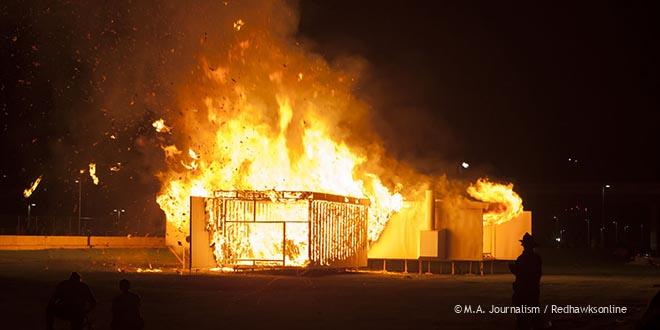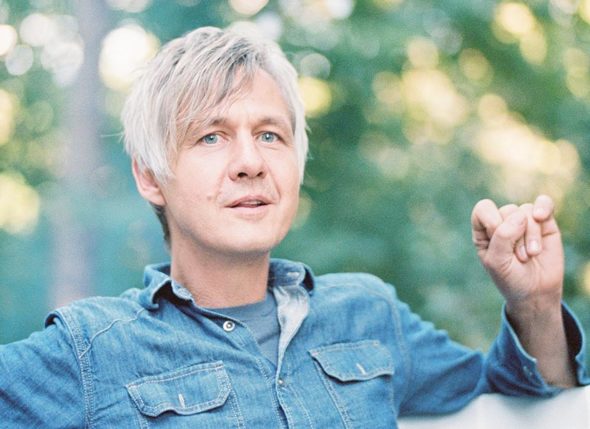Chris Larson (’85) is a Minneapolis based artist and Minnehaha alumnus. His work is extensive and his fields diverse: Videography, photography, performance art, sculpture, among others. His work has been featured in the Walker Art Center and at the Whitney Biennial. This past year, Larson was inducted into the Minnehaha Academy fine Arts Hall of Fame.
Many factors went in to this decision. Aside from the obvious-his world renowned art, his impact on the school community was a factor.
“We saw Chris as someone who, obviously, is a ridiculously accomplished, successful person,” said Nathan Stromberg, art teacher. “His resume is unbelievable, if you look at the awards he’s won and continues to win, exhibiting his art around the world, that qualifies him. Also, he’s been an advocate for us and has been such a cool person to have around as a parent.”
Minnehaha Experience
Larson’s art career, in fact, has some of its roots at Minnehaha. He credits his teachers with engaging a younger, less artistically inclined self, and for allowing flexibility in the classroom. This gave Larson freedom to fashion his classwork into something his own.
“I started [at Minnehaha] in 7th grade. I think my first art class was in 10th grade,” Larson recalled. “The teacher’s name was Gerold Nordstrom, he was a really beautiful, quiet person… He had a couple classes that I took. One was a painting class. He just said ‘pick anything, whatever you want to paint, paint that.”
In these pieces, Larson emulated work that he cared about at the time. This offered a view into the art of replication, something he would continue to do throughout his career.
“At the time I was into punk rock music and I brought in a couple posters and record albums,” Larson continued. “I think that’s a way that a lot of students start. You find something that you love that you want to replicate. It’s such a beautiful way to pay homage but also he tapped into me, where I was at at the moment. Making replicas of Clash posters and Elvis Costello records was the perfect way for me to understand replication. I still replicate today, it’s just in a different format.”
Larson’s time at Minnehaha also helped acquaint him to a new type of art–literature. Reading gave Larson access to the artistic lenses that many authors have and affected his own career in art.
“I was quiet. I wasn’t good at sports. I wasn’t terribly good at academia. I loved to read,” said Larson. “I was really turned on in 10th grade by a couple teachers… [My teacher] had such a huge influence on the way I was thinking in terms of literature. Literature was my first entrance into the art world, the art of writing. She turned me on to JD Salinger’s Catcher in the Rye, Franny and Zooey, and then got into Kurt Vonnegut and got into all of these existential writers and transcendentalism through Thoreau. All of these books just really blew my mind. I was like a sponge absorbing these things. The art had a deep influence on who I became as an artist. That was where I really thrived: in writing and literature. The other classes I really bombed out on. There’s other ways of measuring your accomplishments.”
Growth in Art
It wasn’t until college, however, that Larson became serious about art. He points a specific moment as being one that essentially began his career in creating art, his experience in a woodworking studio at Bethel university where he studied for his undergraduate degree.
“I found myself cutting up some wood and manipulating it. It felt just right,” explained Larson. “It felt like something I wanted to pursue in a deeper way…. It was the feeling that I could manipulate some solid material–wood on a bandsaw into different abstract shapes and pieces of wood. I think it was using my hands versus reading a book or writing that was a different feeling. It was a physical feeling with materials.”
Larson’s experiences in undergraduate school were furthered by his studies at Yale University’s graduate program. He describes graduate school as college tailored to each student. His experiences at Yale primarily consisted of working hard on projects and having that work be critiqued by professors, peers and members of the art community who visited Yale and viewed his work.
“Stewart [my Bethel Professor] had a big [impact on] my life,” Larson said. “He taught me a good work ethic, hard work and to delve deep into my work. Graduate school definitely did that for me. What that taught me, again, was just to go to a studio, close the door and work as hard as you can and to work through ideas quickly and don’t dwell on anything else in the process. Spit out as much as possible and get feedback on it. Those were really important years of my life.”

Career
Since his collegiate years, Larson has created and showcased much of his work. He has received numerous awards, including a recent Guggenheim Fellowship this year.
“[The Guggenheim] is a fellowship that just gives you money to do whatever you propose. I propose, there’s an abandoned sewing factory in Tennessee, east of Nashville. It’s 20 thousand square feet. That means it’s a big chunk of the [Mendota campus]…They were sewing for Ralph Lauren up until 1998. There’s 150 sewing machines. 150 thousand spools of thread down there. There’s so much residue of labor in that space, which is what I want to track and understand how the environments that these people lived in affected how they felt socially or economically… I’m down there for a year. I go every month and I work out of the basement for a couple weeks at a time.”
Recent Work
He recently showed at an exhibit for the Ski Club, a Milwaukee gallery, which had a show in the deserts of California. For this,Larson re-ordered a room in an abandoned home in the desert.
“How I felt like I grew with [the High Desert Test Sites] project is, usually I find architecture it’s pretty nice; my response to [the conference room at Mendota] would be to distress it or alter it or change it. That space had already been severely affected. There was nothing I could do to distress it anymore. So, the response came to be to clean it up and transform it. ‘Transformation,’ I guess, is a big word. The word transformation can lie in order and disorder or destruction which is in a lot of my work. Through that act there is some type of order or disorder that’s created.”
Larson credits this “performative” type of art as his favorite to create. For him, it isn’t who sees his work or its longevity, it’s the fact that he did something and changed something, if a small change in the grand scheme of things.
“I don’t know how you would define the work I did in the desert. It was more of an action. As I look at my work a lot of it is performative, meaning I perform in my studio, or this,” Larson explains with an example. He moves a coffee bottle onto a Talon and tops it with his keys. “There’s a performance that happens. Maybe that’s what I’m tracking. I performed or I did an action in the desert with that house. I don’t know how you would classify that art but the closest would be performing. My body doing something in a space. It lives in a story right now that I told you.”
A long-time supporter of his work is the Walker Art Center in Minneapolis, buying and supporting his pieces since the beginning of his career.
“The Walker Art Center has been so supportive of my work, going back to honestly the beginning,” said Larson. “The first time they purchases and showed my work was in ’98. I just got a letter recently, they just bought my last exhibition. It’s called “Land Speed Record” from 2016. They just purchased the entire show which is super exciting. The Walker is way up there [in terms of exhibits]. Because they have supported my career from the beginning until now they are still committed to my work. It’s so special. I’m flattered, I’m honored and I’m grateful. They now have eight of my works, and big substantial moments in my career which is really incredible.”
The Value of Art
To Larson, art is like other creative pieces. It doesn’t need to be deconstructed to uncover its value. It simply is what it is and should be enjoyed as thus.
“I wish the first question people had when they looked at art wasn’t ‘what does it mean?’ I wish they wouldn’t do that. I wish they would absorb it like a book or a movie or a song. I don’t think people listen to a song and go ‘what does that mean?.’ Art is something so incredible and so different from literature and music. You look at something like this and it makes you think. Let it make you think. Don’t try to ask what that means.”
Larson is also a Minnehaha parent. His son, Silas Zulkosky Larson is a junior at Minnehaha. Zulkosky Larson stated that his father’s career gave him opportunities to travel to shows in places like Cincinnati, New York, and Berlin. He says he respects how hard working his father is. “He works hard. All day, everyday,” he said. Generally, he said his father’s motto is “If you don’t know what to make just make. Start making things.”
Larson’s art has exhibited across the US and the world. As he continues to make art share ideas, it is clear that his work will continue to impact, be it a frozen building or an abandoned sewing factory. Whether in the studio, in the classroom, or on a trip for his work, Larson sees this as part of his larger narrative.
“I’ve been trying to see myself form above. If you had a space eye view of who I am in the world, it all becomes the same thing. Me as an artist, me as a teacher, me as a dad. It’s an extension of what I do.”
With his humble spirit, work ethic and care for the school, Larson will continue to be an invaluable member of the Minnehaha community.
“He’s always been sort of a hero of mine,” laughed Stromberg. “I teased him about that at the opening. This is someone that I’ve looked up to forever. He’s so good at what he does. The coolest thing has just been teaching his kids and getting to know him more.”


